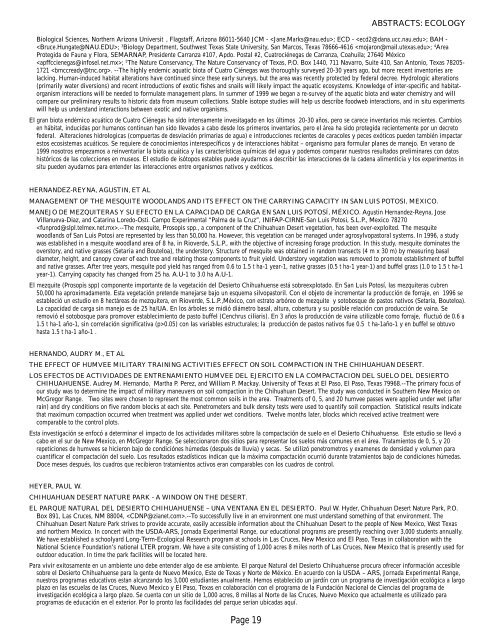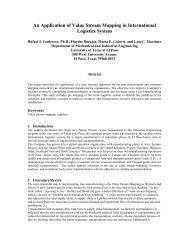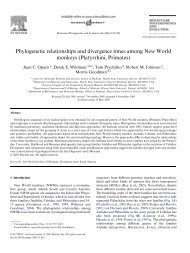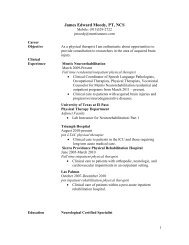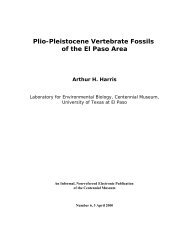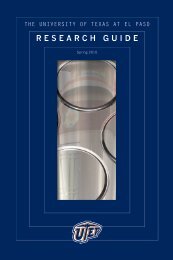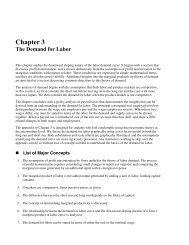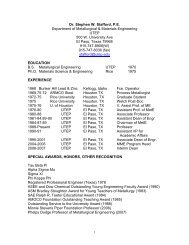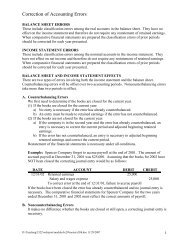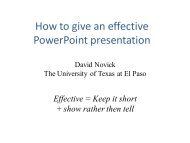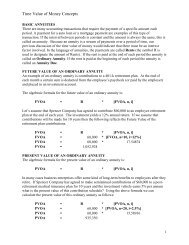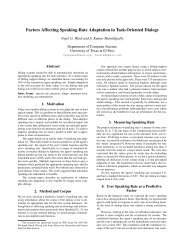Sym - Abstracts - University of Texas at El Paso
Sym - Abstracts - University of Texas at El Paso
Sym - Abstracts - University of Texas at El Paso
Create successful ePaper yourself
Turn your PDF publications into a flip-book with our unique Google optimized e-Paper software.
ABSTRACTS: ECOLOGY<br />
Biological Sciences, Northern Arizona Universit , Flagstaff, Arizona 86011-5640 JCM - ; ECD - ; BAH -<br />
; 3 Biology Department, Southwest <strong>Texas</strong> St<strong>at</strong>e <strong>University</strong>, San Marcos, <strong>Texas</strong> 78666-4616 ; 4 Area<br />
Protegida de Fauna y Flora, SEMARNAP, Presidente Carranza #107, Apdo. Postal #2, Cu<strong>at</strong>rociénegas de Carranza, Coahuila; 27640 México<br />
; 5 The N<strong>at</strong>ure Conservancy, The N<strong>at</strong>ure Conservancy <strong>of</strong> <strong>Texas</strong>, P.O. Box 1440, 711 Navarro, Suite 410, San Antonio, <strong>Texas</strong> 78205-<br />
1721 . --The highly endemic aqu<strong>at</strong>ic biota <strong>of</strong> Cu<strong>at</strong>ro Ciénegas was thoroughly surveyed 20-30 years ago, but more recent inventories are<br />
lacking. Human-induced habit<strong>at</strong> alter<strong>at</strong>ions have continued since these early surveys, but the area was recently protected by federal decree. Hydrologic alter<strong>at</strong>ions<br />
(primarily w<strong>at</strong>er diversions) and recent introductions <strong>of</strong> exotic fishes and snails will likely impact the aqu<strong>at</strong>ic ecosystems. Knowledge <strong>of</strong> inter-specific and habit<strong>at</strong>organism<br />
interactions will be needed to formul<strong>at</strong>e management plans. In summer <strong>of</strong> 1999 we began a re-survey <strong>of</strong> the aqu<strong>at</strong>ic biota and w<strong>at</strong>er chemistry and will<br />
compare our preliminary results to historic d<strong>at</strong>a from museum collections. Stable isotope studies will help us describe foodweb interactions, and in situ experiments<br />
will help us understand interactions between exotic and n<strong>at</strong>ive organisms.<br />
<strong>El</strong> gran biota endémico acuático de Cu<strong>at</strong>ro Ciénegas ha sido intensamente invesitagado en los últimos 20-30 años, pero se carece inventarios más recientes. Cambios<br />
en hábit<strong>at</strong>, inducidas por humanos continuan han sido llevados a cabo desde los primeros inventarios, pero el área ha sido protegida recientemente por un decreto<br />
federal. Alteraciones hidrologicas (compuertas de desviación primarias de agua) e introducciones recientes de caracoles y peces exóticos pueden también impactar<br />
estos ecosistemas acuáticos. Se requiere de conocimientos interespecíficos y de interacciones hábit<strong>at</strong> – organismo para formular planes de manejo. En verano de<br />
1999 nosotros empezamos a reinventariar la biota acuática y las características químicas del agua y podemos comparar nuestros resultados preliminares con d<strong>at</strong>os<br />
históricos de las colecciones en museos. <strong>El</strong> estudio de isótopos estables puede ayudarnos a describir las interacciones de la cadena alimenticia y los experimentos in<br />
situ pueden ayudarnos para entender las interacciones entre organismos n<strong>at</strong>ivos y exóticos.<br />
HERNANDEZ-REYNA, AGUSTIN, ET AL<br />
MANAGEMENT OF THE MESQUITE WOODLANDS AND ITS EFFECT ON THE CARRYING CAPACITY IN SAN LUIS POTOSI, MEXICO.<br />
MANEJO DE MEZQUITERAS Y SU EFECTO EN LA CAPACIDAD DE CARGA EN SAN LUIS POTOSÍ, MÉXICO. Agustin Hernandez-Reyna, Jose<br />
Villanueva-Diaz, and C<strong>at</strong>arina Loredo-Osti. Campo Experimental “Palma de la Cruz”, INIFAP-CIRNE-San Luis Potosi, S.L.P., Mexico 78270<br />
.--The mesquite, Prosopis spp., a component <strong>of</strong> the Chihuahuan Desert veget<strong>at</strong>ion, has been over-exploited. The mesquite<br />
woodlands <strong>of</strong> San Luis Potosi are represented by less than 50,000 ha. However, this veget<strong>at</strong>ion can be managed under agrosylvopastoral systems. In 1996, a study<br />
was established in a mesquite woodland area <strong>of</strong> 8 ha, in Rioverde, S.L.P., with the objective <strong>of</strong> increasing forage production. In this study, mesquite domin<strong>at</strong>es the<br />
overstory, and n<strong>at</strong>ive grasses (Setaria and Bouteloa), the understory. Structure <strong>of</strong> mesquite was obtained in random transects (4 m x 30 m) by measuring basal<br />
diameter, height, and canopy cover <strong>of</strong> each tree and rel<strong>at</strong>ing those components to fruit yield. Understory veget<strong>at</strong>ion was removed to promote establishment <strong>of</strong> buffel<br />
and n<strong>at</strong>ive grasses. After tree years, mesquite pod yield has ranged from 0.6 to 1.5 t ha-1 year-1, n<strong>at</strong>ive grasses (0.5 t ha-1 year-1) and buffel grass (1.0 to 1.5 t ha-1<br />
year-1). Carrying capacity has changed from 25 ha. A.U-1 to 3.0 ha A.U-1.<br />
<strong>El</strong> mezquite (Prosopis spp) componente importante de la vegetación del Desierto Chihuahuense está sobreexplotado. En San Luis Potosí, las mezquiteras cubren<br />
50,000 ha aproximadamente. Esta vegetación pretende manejarse bajo un esquema silvopastoril. Con el objeto de incrementar la producción de forraje, en 1996 se<br />
estableció un estudio en 8 hectáreas de mezquitera, en Rioverde, S.L.P.,México, con estr<strong>at</strong>o arbóreo de mezquite y sotobosque de pastos n<strong>at</strong>ivos (Setaria, Bouteloa).<br />
La capacidad de carga sin manejo es de 25 ha/UA. En los árboles se midió diámetro basal, altura, cobertura y su posible relación con producción de vaina. Se<br />
removió el sotobosque para promover establecimiento de pasto buffel (Cenchrus ciliaris). En 3 años la producción de vaina utilizable como forraje, fluctuó de 0.6 a<br />
1.5 t ha-1 año-1, sin correlación signific<strong>at</strong>iva (p>0.05) con las variables estructurales; la producción de pastos n<strong>at</strong>ivos fue 0.5 t ha-1año-1 y en buffel se obtuvo<br />
hasta 1.5 t ha-1 año-1 .<br />
HERNANDO, AUDRY M., ET AL<br />
THE EFFECT OF HUMVEE MILITARY TRAINING ACTIVITIES EFFECT ON SOIL COMPACTION IN THE CHIHUAHUAN DESERT.<br />
LOS EFECTOS DE ACTIVIDADES DE ENTRENAMIENTO HUMVEE DEL EJERCITO EN LA COMPACTACION DEL SUELO DEL DESIERTO<br />
CHIHUAHUENSE. Audrey M. Hernando, Martha P. Perez, and William P. Mackay. <strong>University</strong> <strong>of</strong> <strong>Texas</strong> <strong>at</strong> <strong>El</strong> <strong>Paso</strong>, <strong>El</strong> <strong>Paso</strong>, <strong>Texas</strong> 79968.--The primary focus <strong>of</strong><br />
our study was to determine the impact <strong>of</strong> military maneuvers on soil compaction in the Chihuahuan Desert. The study was conducted in Southern New Mexico on<br />
McGregor Range. Two sites were chosen to represent the most common soils in the area. Tre<strong>at</strong>ments <strong>of</strong> 0, 5, and 20 humvee passes were applied under wet (after<br />
rain) and dry conditions on five random blocks <strong>at</strong> each site. Penetrometers and bulk density tests were used to quantify soil compaction. St<strong>at</strong>istical results indic<strong>at</strong>e<br />
th<strong>at</strong> maximum compaction occurred when tre<strong>at</strong>ment was applied under wet conditions. Twelve months l<strong>at</strong>er, blocks which received active tre<strong>at</strong>ment were<br />
comparable to the control plots.<br />
Esta investigación se enfocó a determinar el impacto de los actividades militares sobre la compactación de suelo en el Desierto Chihuahuense. Este estudio se llevó a<br />
cabo en el sur de New Mexico, en McGregor Range. Se seleccionaron dos sitios para representar los suelos más comunes en el área. Tr<strong>at</strong>amientos de 0, 5, y 20<br />
repeticiones de humvees se hicieron bajo de condiciónes húmedas (después de lluvia) y secas. Se utilizó penetrometros y examenes de densidad y volumen para<br />
cuantificar el compactación del suelo. Los resultados estadísticos indican que la máxima compactación ocurrió durante tr<strong>at</strong>amientos bajo de condiciones húmedas.<br />
Doce meses después, los cuadros que recibieron tr<strong>at</strong>amientos activos eran comparables con los cuadros de control.<br />
HEYER, PAUL W.<br />
CHIHUAHUAN DESERT NATURE PARK - A WINDOW ON THE DESERT.<br />
EL PARQUE NATURAL DEL DESIERTO CHIHUAHUENSE – UNA VENTANA EN EL DESIERTO. Paul W. Hyder, Chihuahuan Desert N<strong>at</strong>ure Park, P.O.<br />
Box 891, Las Cruces, NM 88004, .--To successfully live in an environment one must understand something <strong>of</strong> th<strong>at</strong> environment. The<br />
Chihuahuan Desert N<strong>at</strong>ure Park strives to provide accur<strong>at</strong>e, easily accessible inform<strong>at</strong>ion about the Chihuahuan Desert to the people <strong>of</strong> New Mexico, West <strong>Texas</strong><br />
and northern Mexico. In concert with the USDA-ARS, Jornada Experimental Range, our educ<strong>at</strong>ional programs are presently reaching over 3,000 students annually.<br />
We have established a schoolyard Long-Term-Ecological Research program <strong>at</strong> schools in Las Cruces, New Mexico and <strong>El</strong> <strong>Paso</strong>, <strong>Texas</strong> in collabor<strong>at</strong>ion with the<br />
N<strong>at</strong>ional Science Found<strong>at</strong>ion’s n<strong>at</strong>ional LTER program. We have a site consisting <strong>of</strong> 1,000 acres 8 miles north <strong>of</strong> Las Cruces, New Mexico th<strong>at</strong> is presently used for<br />
outdoor educ<strong>at</strong>ion. In time the park facilities will be loc<strong>at</strong>ed here.<br />
Para vivir exitosamente en un ambiente uno debe entender algo de ese ambiente. <strong>El</strong> parque N<strong>at</strong>ural del Desierto Chihuahuense procura <strong>of</strong>recer información accesible<br />
sobre el Desierto Chihuahuense para la gente de Nuevo Mexico, Este de <strong>Texas</strong> y Norte de México. En acuerdo con la USDA – ARS, Jornada Experimental Range,<br />
nuestros programas educ<strong>at</strong>ivos estan alcanzando los 3,000 estudiantes anualmente. Hemos establecido un jardín con un programa de investigación ecológica a largo<br />
plazo en las escuelas de las Cruces, Nuevo Mexico y <strong>El</strong> <strong>Paso</strong>, <strong>Texas</strong> en colaboración con el programa de la Fundación Nacional de Ciencias del programa de<br />
investigación ecológica a largo plazo. Se cuenta con un sitio de 1,000 acres, 8 millas al Norte de las Cruces, Nuevo Mexico que actualmente es utilizado para<br />
programas de educación en el exterior. Por lo pronto las facilidades del parque serian ubicadas aquí.<br />
Page 19


